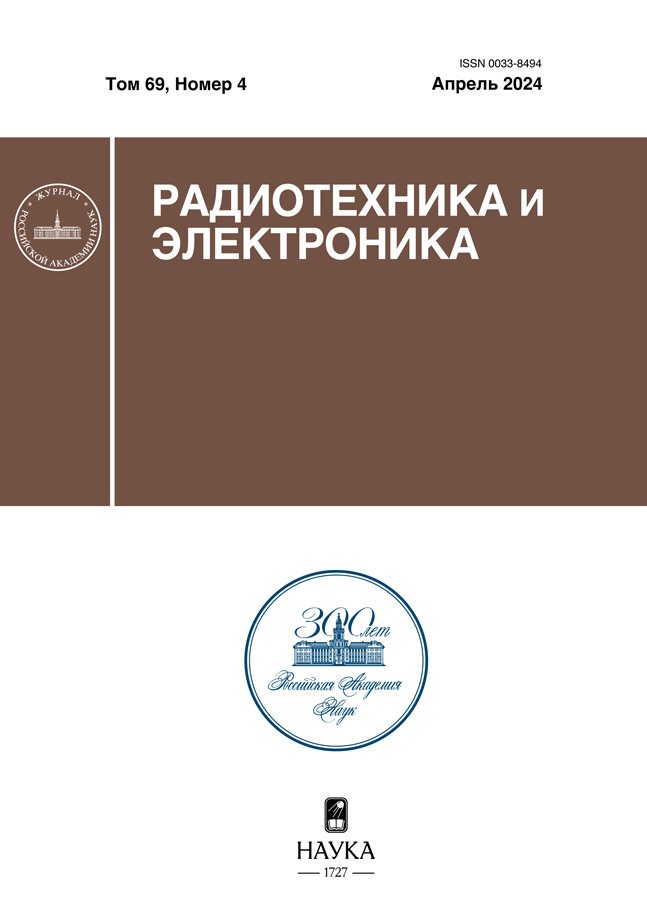The proposed mechanism of glow of mesosphere clouds
- Autores: Bordonskiy G.S.1, Gurulev A.A.1, Orlov A.O.1, Kazantsev V.A.1
-
Afiliações:
- Institute of Natural Resources, Ecology and Cryology of the Siberian Branch of the RAS
- Edição: Volume 69, Nº 4 (2024)
- Páginas: 307-315
- Seção: ЭЛЕКТРОДИНАМИКА И РАСПРОСТРАНЕНИЕ РАДИОВОЛН
- URL: https://cijournal.ru/0033-8494/article/view/650684
- DOI: https://doi.org/10.31857/S0033849424040013
- EDN: https://elibrary.ru/JSHGWK
- ID: 650684
Citar
Texto integral
Resumo
The question of the physical mechanism of electromagnetic radiation scattering by mesospheric (noctilucent) clouds is considered. A hypothesis has been expressed about the special electromagnetic characteristics of nanometer-sized ice particles that make up mesospheric clouds. Particle ice consists of a recently discovered crystalline modification of water — ice 0, formed by the condensation of vapor on dust particles at temperatures of –140…–23°C. Ice 0 is a ferroelectric, and upon contact with a dielectric, a layer with high electrical conductivity is formed. Due to plasmon resonance in nanosized layers, strong scattering of electromagnetic radiation occurs over a wide frequency range. This mechanism causes the glow of noctilucent clouds when illuminated by the radiation of the Sun.
Palavras-chave
Texto integral
Sobre autores
G. Bordonskiy
Institute of Natural Resources, Ecology and Cryology of the Siberian Branch of the RAS
Autor responsável pela correspondência
Email: lgc255@mail.ru
Rússia, Chita, 672002
A. Gurulev
Institute of Natural Resources, Ecology and Cryology of the Siberian Branch of the RAS
Email: lgc255@mail.ru
Rússia, Chita, 672002
A. Orlov
Institute of Natural Resources, Ecology and Cryology of the Siberian Branch of the RAS
Email: lgc255@mail.ru
Rússia, Chita, 672002
V. Kazantsev
Institute of Natural Resources, Ecology and Cryology of the Siberian Branch of the RAS
Email: lgc255@mail.ru
Rússia, Chita, 672002
Bibliografia
- Russell J. // Global Change and the Solar-Terrestrial Environment. 12–17 Jun. 2010, Aspen. Р. 1. https://www.agci.org/wp-content/uploads/imported-files/2022/07/10S1_0616_JRussell.pdf
- Romejko V.A., Dalin P.A., Pertsev N.N. // J. Geophys. Res. Atmos. 2003. V. 108. № D8. P. 8443. https://doi.org/10.1029/2002JD002364
- Dalin P., Pertsev N., Perminov V. et al. // Ann. Geophys. 2020. V. 38. № 1. P. 61. https://doi.org/10.5194/angeo-38-61-2020
- Бронштэн В.А., Гришин Н.И. Серебристые облака. М.: Наука, 1970.
- Thomas G.E. // Adv. Space Res. 2003. V. 32. № 9. P. 1737. https://doi.org/10.1016/S0273-1177(03)90470-4
- DeLand M.T., Shettle E.P., Thomas G.E., Olivero J.J. // J. Atmos. Sol.-Terr. Phys. 2006. V. 68. № 1. P. 9. https://doi.org/10.1016/j.jastp.2005.08.003
- Ролдугин В.К., Черняков С.М., Ролдугин А.В., Оглоблина О.Ф. // Геомагнетизм и аэрономия. 2018. Т. 58. № 3. С. 343. https://doi.org/10.7868/S0016794018030045
- Rapp M., Lübken F.J. // J. Geophys. Res. Atmos. 2009. V. 114. № D11. P. D11204. https://doi.org/10.1029/2008JD011323
- Murray B.J., Plane J.M.C. // Phys. Chem. Chem. Phys. 2005. V. 7. № 23. P. 3970. https://doi.org/10.1039/B508846A
- Thomas G.E., Olivero J.J., Jensen E.J. et al. // Nature. 1989. V. 338. № 6215. P. 490. https://doi.org/10.1038/338490a0
- von Savigny C., Sinnhuber M., Bovensmann H. et al. // Geophys. Res. Lett. 2007. V. 34. № 2. P. L02805. https://doi.org/10.1029/2006GL028106
- Бордонский Г.С., Гурулев А.А. // Письма в ЖТФ. 2017. Т. 43. № 8. С. 34. https://doi.org/10.21883/PJTF.2017.08.44532.16338
- Tromp T.K., Shia R.L., Allen M. et al. // Sci. 2003. V. 300. № 5626. P. 1740. https://doi.org/10.1126/science.1085169
- Сывороткин В.Л. Экологические аспекты дегазации Земли. М.: Геоинформмарк, 1998.
- Bordonskiy G.S., Gurulev A.A., Orlov A.O. // Proc. SPIE. 25th Intern. Symp. on Atmospheric and Ocean Optics: Atmospheric Physics. 01–05 July 2019, Novosibirsk, Russia. Washington: SPIE, 2019. V. 11208. P. 1120818. https://doi.org/10.1117/12.2539769
- Russo J., Romano F., Tanaka H. // Nature Mater. 2014. V. 13. № 7. P. 733. https://doi.org/10.1038/NMAT3977
- Quigley D., Alfè D., Slater B. // J. Chem. Phys. 2014. V. 141. № 16. P. 161102. https://doi.org/10.1063/1.4900772
- Бордонский Г.С., Орлов А.О. // Письма в ЖЭТФ. 2017. Т. 105. № 7–8. С. 483. https://doi.org/10.7868/S0370274X17080045
- Борен К., Хафмен Д. Поглощение и рассеяние света малыми частицами. М.: Мир, 1986.
- Korobeynikov S.M., Drozhzhin A.P., Furin V.P. et al. // Proc. of 2002 IEEE14th ICDL. 12 July 2002, Graz, Austria. N.Y.: IEEE, 2002. P. 270. https://doi.org/10.1109/ICDL.2002.1022681
- Korobeynikov S.M., Melekhov A.V., Soloveitchik Yu.G. et al. // J. Phys. D: Appl. Phys. 2005. V. 38. № 6. P. 915. https://doi.org/10.1088/0022-3727/38/6/021
- Бордонский Г.С., Гурулев А.А., Орлов А.О. // Письма в ЖЭТФ. 2020. Т. 111. № 5. С. 311. https://doi.org/10.31857/S0370274X20050070
- Leoni F., Russo J. // Phys. Rev. X. 2021. V. 11. № 3. P. 031006. https://doi.org/10.1103/PhysRevX.11.031006
- Solveyra E.G., Llave E., Scherlis D.A., Molinero V. // J. Phys. Chem. B. 2011. V. 115. Iss. 48. P. 14196. https://doi.org/10.1021/jp205008w
- Климов В. В. Наноплазмоника. М.: Физматлит, 2009.
- Болтаев А.П., Пенин Н.А., Погосов А.О., Пудонин Ф.А. // ЖЭТФ. 2003. Т. 123. № 5. С. 1067.
- Болтаев А.П., Пудонин Ф.А. // Краткие сообщ. по физике ФИАН. 2011. № 7. С. 3.
- Муравьев В.М., Кукушкин И.В. // Успехи физ. наук. 2020. Т. 190. № 10. С. 1041. https://doi.org/10.3367/UFNr.2019.07.038637
- Альшиц В.И., Любимов В.Н. // Письма в ЖЭТФ. 2020. Т. 112. № 2. С. 127. https://doi.org/10.31857/S1234567820140128
- Невзоров А.Н. // Изв. РАН. Физика атмосферы и океана. 2006. Т. 42. № 6. С. 830.
- Кутуза Б.Г., Данилычев М.В., Яковлев О.И. Спутниковый мониторинг Земли: Микроволновая радиометрия атмосферы и поверхности. М.: Ленадд, 2016.
- Томилина О.А., Бержанский В.Н., Томилин С.В. // ФТТ. 2020. Т. 62. № 4. С. 614. https://doi.org/10.21883/FTT.2020.04.49129.610
Arquivos suplementares


















